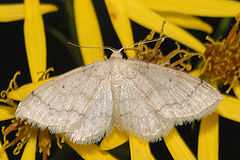Idaea subsericeata
| Idaea subsericeata | |
|---|---|
 | |
| Scientific classification | |
| Kingdom: | Animalia |
| Phylum: | Arthropoda |
| Class: | Insecta |
| Order: | Lepidoptera |
| Family: | Geometridae |
| Subfamily: | Sterrhinae |
| Genus: | Idaea |
| Species: | I. subsericeata |
| Binomial name | |
| Idaea subsericeata Haworth, 1809 | |
The Satin Wave (Idaea subsericeata) is a moth of the family Geometridae. It is found in Central and South Europe, North Africa, Asia Minor to Transcaspia.
Description
The ground colour is white with strong silky gloss, the lines grey, seldom strongly expressed, on the other hand usually all present, thus numbering 5 on the forewing and 4 on the hindwing; the outermost line (distal shading of subterminal) the oftenest absent; all except the median are parallel with the distal margin, but slightly wavy; the median on the forewing is usually somewhat oblique, but occasionally almost parallel with the others; that of the hindwing runs straighter across the wing, instead of following the curve of the strongly convex distal margin. Cellspots and terminal line wanting or rarely the former present, minute; fringe usually with a series of minute black dots at the base, which are sometimes in part, more rarely entirely obsolete. Forewing beneath often with a smoky suffusion, either basally or all over; median and postmedian lines present, often well developed;a small discal dot present. Hindwing beneath white, with discal dot and postmedian line. Male antennal ciliation little longer than diameter of shaft; hindtarsus short. Not on the whole an extremely variable species, except in size; there is, however, a great deal of trivial variation, i. e. as regards the absolute or relative strength of the several lines, the close proximity of the inner subterminal to the postmedian or their widerseparation, the degree of suffusion of the under surface, etc. Second-brood specimens, besides being smaller seem to be on an average whiter beneath and are sometimes rounder-winged. [1]
The species has a wingspan of 22–25 mm. The adults fly in one generation from June to July .
The larvae feed on low growing plants such as knotgrass, dandelion and chickweed.
Notes
- ^ The flight season refers to the British Isles. This may vary in other parts of the range.
References
- ↑ Prout , L.B. 1912–16. Geometridae. In A. Seitz (ed.) The Macrolepidoptera of the World. The Palaearctic Geometridae, 4. 479 pp. Alfred Kernen, Stuttgart.